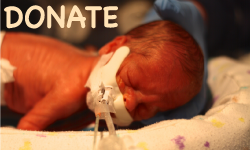FAQ
How old is Tucker?
It depends who you ask.
Tucker’s birth date was July 13, 2012….but he was born 15 weeks early, so he kind of has two ages – his “actual age” meaning how old he is since July 13, 2012. And he has an “adjusted age,” which is how old he would be if he was born on his expected due date, October 21, 2012.
How do you measure Tucker’s development?
Until he is about 2 or 3 years of age, Tucker will be measured according to his “adjusted age.” So right now, for example, even though he is 12 months out of the womb, he’s hypothetically a 9 month old. You also have to put into consideration all of the time that he spent in the hospital…which was 10.5 months.
What birth defects was Tucker born with?
Tucker was born with esophageal atresia and radial aplasia. These two congenital birth defects are a part of VACTERL association which is a sporadic, non-random set of birth defects.
Did you know about Tucker’s birth defects before he was born?
Yes. We found out about both birth defects at Ellie’s 20 week ultrasound.
What causes the birth defects associated with VACTERL Association?
There is no known cause for Tucker’s birth defects. They are neither chromosomal nor genetic. Tucker has typical “male chromosomes.”
After conception, Tucker’s embryo was normal. It is believed that between days 23 and 37 after conception, something goes awry that causes the birth defects.
Did you know Tucker would be born so early?
Yes and no. We knew there was a good chance Tucker would be born early, but we weren’t prepared for him to be born fifteen weeks early.
Often times babies with esophageal atresia are born early because they can’t swallow amniotic fluid while in utero and regulate the fluid level. So moms tend to develop polyhydramnios and are unable to make it to full term because they are retaining so much fluid.
What was the reason for Tucker’s early delivery?
Although Ellie had some early polyhydramnios, it was Tucker’s heart rate that ultimately led to his early delivery. Tucker’s heart rate began to drop during routine fetal monitoring and after several epsiodes of heart decels, Tucker was delivered via emergency c-section.
We still don’t know why Tucker’s heart rate dropped in utero and we probably never will.
What complications does Tucker have from prematurity?
Tucker had a PDA ligation at 4 weeks old. He also developed Level 3 ROP and had Laser surgery in both eyes to prevent the progression of ROP.
The biggest complication Tucker faces from being born so premature is Chronic Lung Disease and BPD (bronchopulmonary displasia) – which takes months/years to outgrow.
Why did Tucker go to Boston?
In November of 2012, we transferred Tucker to Boston Children’s Hospital to receive care under their Esophageal Atresia Treatment Center. Boston has one of the leading centers for this birth defect and they offer a unique method to repair the esophagus, the Foker Method.
How long were you in Boston?
5 months. Boston originally told us to expect to be there 2-4 months just for the course of the esophagus surgery. Tucker’s big surgery was delayed by a month in order to get his lungs a little healthier/stronger. We’ve met other families whose child has Tucker’s same birth defect and they’ve been there for 1 -2 years. It’s a complicated diagnosis and can have varying outcomes based on the child.
Where can I learn more about Tucker’s birth defect, the Foker procedure, and the long-term prognosis for children with Esophageal Atresia?
Check out this link: http://www.childrenshospital.org/az/Site1775/mainpageS1775P4.html.

